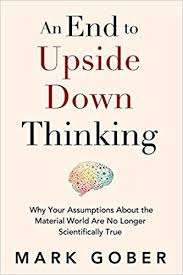An End to Upside Down Thinking by Mark Gober
What's It About?
Why do we have consciousness?The mainstream view, expressed by Carl Sagan in 1977, is: “[The brain’s] workings – what we sometimes call mind – are a consequence of its anatomy and physiology and nothing more.” But what in its anatomy and physiology? Said neuroscientist Sam Harris in 2015, “There is nothing about a brain, studied at any scale, that even suggests that it might harbor consciousness.”
So is mainstream science trying to find the harbor? Not very much.
Said physicist Lee Smolin in 2013, “…whereas there are real mysteries about consciousness, they’re beyond what science can tackle with present knowledge.”
Since they supposedly can’t be tackled? Dr. Eben Alexander, formerly a Harvard Medical School associate professor in brain surgery, says that much – maybe most – of mainstream science has labeled consciousness “a total nonproblem.”
But in a new book, An End to Upside Down Thinking (Waterside Press), Mark Gober tackles the problem and concludes the brain doesn’t produce consciousness. Instead, consciousness exists outside the brain. What’s more, consciousness creates all material reality.
That’s what Gober means by “upside down thinking.” While we think materialism creates thought, it’s really the other way around. And he hopes his book puts an end to this mistaken thinking.
What’s more, says Gober:
- Consciousness exists beyond space and time.
- When our body dies, our consciousness does not die.
- We are all fundamentally interconnected as part of the same underlying consciousness.
- We all have latent psychic abilities.
How did Gober – magna cum laude from Princeton, a former investment banking analyst who is now a senior member of Sherpa Technology Group in Silicon Valley – start down this path?
He learned of an abundance of controlled studies in peer-reviewed journals that suggest psychic phenomena are real. And he learned that statistical support for psychic phenomena “is stronger than the evidence showing that aspirin prevents heart attacks.” So Gober investigated further. He found what he considers to be evidence, and he presents it:
From psychedelics and near-death experiences. From communications with the deceased. From memory and personality transmitted via heart transplants. From studies in telepathy, precognition and psychokinetic.
From terminal lucidity: “the unexpected return of mental clarity and memory shortly before death in patients suffering from severe psychiatric and neurological disorders.”
From people with savant syndrome, Gober quotes one clinical professor of psychiatry who has studied autistic savants: “(they) know so many things they haven’t learned, it’s almost as if they tapped into a universal knowledge.”
And from “lives beyond this one,” Gober cites studies of young children who claim to have led previous lives. Some speak foreign languages they had no way of knowing; some have distinctive birthmarks or physical deformities that correlate to how they say they died in previous lives.
Having presented this evidence, Gober says, “Let’s assume that consciousness isn’t produced by the brain. Let’s assume that ‘somehow’ the brain accesses consciousness from outside the body….How?…The short answer is: I don’t know.”
But he presents at least one theory:
The Oxford mathematical physicist Roger Penrose (who collaborated and co-authored books with Stephen Hawking) and University of Arizona anesthesiologist Dr. Stuart Hammeroff propose “That consciousness depends on biologically ‘orchestrated’ quantum computations in collections of microtubules within brain neutrons.” And, says Dr. Hammeroff, this quantum information can’t be destroyed. “If the patient dies, it’s possible that this quantum information can exist outside the body, perhaps indefinitely.”
If consciousness does exist outside the brain, Gober considers its implications:
For artificial intelligence. For systems to warn of earthquakes, tsunamis, avalanches, storms, et cetera. For personal and national security. For scientific experimentation.
For our mental and physical health. For our understanding of science, technology and the universe. For our view of death. For whether life has deeper meaning. For our conceptions of love and beauty. For achieving happiness and world peace.
Gober raises “common sense” objections to his theory: “How is everything ‘in the mind’ when we know we are in a reality that at its core comprises space, time, and matter?” “How can you say that what I see, objects and people who are separate from me, are not separate but instead ‘we are all one’?” “How can you claim that my experiences – what I did in the past – are illusions?”
And he supplies answers.
Will you buy his answers? Will you buy his theory?
If he’s right? Says Dr. Eben Alexander, Mark Gober’s theory “will make the Copernican Revolution seem relatively minor by comparison.’”
An End to Upside Down Thinking is now available to purchase.






